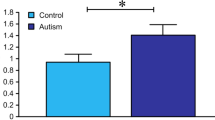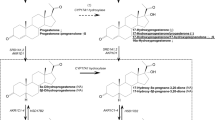Abstract
Plasma levels of testosterone and the adrenal androgen dehydroepiandrosterone sulfate (DHEA-S) were measured in male autistic subjects (31 prepubertal, 8 postpubertal), mentally retarded/cognitively impaired subjects (MR, 12 prepubertal), and normal control subjects (NC, 10 prepubertal, 11 postpubertal). Mean levels of plasma testosterone were similar in the postpubertal autistic (4.54+1.12 ng/ml) and postpubertal NC (5.02±1.87 ng/ml) groups. Plasma DHEA-S levels in postpubertal autistic (2170±1020 ng/ml) and postpubertal NC (1850±77 ng/ml) groups also were not significantly different. Similarly, no significant group differences were seen for testosterone or DHEA-S in the prepubertal autistic, MR, or NC individuals, although prepubertal MR individuals with cerebral palsy did have increased plasma DHEA-S levels compared to age-matched MR or NC individuals. Significant negative correlations were found between testosterone and whole blood serotonin (5-HT) levels in the combined (all subjects, all ages) groups and in the autistic group, suggesting that the effect of puberty on whole blood 5-HT may deserve further study. Data indicate that altered secretion of the androgens is not a common feature of autism. However, abnormalities of adrenal androgen secretion may be present in individuals with cerebral palsy.
Similar content being viewed by others
References
Achenbach, T. (1991).Manual for the Child Behavior Checklist/14–18 and 1991 Profile, Burlington: University of Vermont Department of Psychiatry.
Ahlenius, S., Larsson, K., Svensson, L., Hjorth, S., Carlsson, A., Lindberg, P., Wikstrom, H., Sanchez, D., Arvidsson, L. E., Hacksell, V., & Nilsson, J. F. G. (1981). Effects of a new type of 5-HT receptor agonist on male rat sexual behavior.Pharmacology, Biochemistry, and Behavior, 15, 785–792.
American Psychiatric Association. (1987).Diagnostic and statistical manual of mental disorders (3rd ed., rev.). Washington, DC: Author.
Anderson, G. M., Feibel, F. C., & Cohen, D. J. (1987). Determination of serotonin in whole blood, PRP, PPP and plasma ultrafiltrate.Life Sciences, 40, 1063–1070.
Anderson, G. M., Horne, W. C., Chatterjee, D., & Cohen, D. J. (1990). The hyperserotonemia of autism.Annals of the New York Academy of Science, 600, 331–342.
Archer, J. (1991). The influence of testosterone on human aggression.British Journal of Psychology, 82, 1–28.
Biegon, A. (1990). Effects of steroid hormones on the serotonergic system.Annals of the New York Academy of Science, 600, 427–434.
Brambilla, F., Viani, F., & Rossotti, V. (1969). Endocrine aspects of child psychosis.Diseases of the Nervous System, 30, 627–632.
Bregman, J. D., Dykens, E., Watson, M., Ort, S. I., & Leckman, J. F. (1987). Fragile-X syndrome: Variability of phenotypic expression.Journal of the American Academy of Child and Adolescent, 26, 463–471.
Durwen, H. F. (1989). Comment on the contribution by L. Hermie and G. Oepen. Hemispheric laterality and early childhood autism.Nervenarzt, 60, 370.
Eichelman, B. (1992). Aggressive behavior: From laboratory to clinic-Quo Vadit?Archives of General Psychiatry, 49, 488–492.
Geschwind, N., & Galaburda, A. M. (1985a). Cerebral lateralization, biological mechanisms, associations, and pathology. I: A hypothesis.Archives of Neurology, 42, 521–551.
Geschwind, N., & Galaburda, A. M. (1985). Cerebral lateralization, biological mechanisms, associations, and pathology. II: A program for research.Archives of Neurology, 42, 634–654.
Gillberg, C. (1984). Infantile autism and other childhood psychoses in a Swedish region: Epidemiological aspects.Journal of Child Psychology and Psychiatry, 25, 35–43.
Hermie, L., & Oepen, G. (1987). Hemispheric laterality and early childhood autism.Nervenarzt, 58, 644–647.
Hoshino, Y., Watanabe, M., Tachibana, R., Murata, S., Kaneko, M., Yashimo, Y., & Kumashiro, H. (1983). A study of the hypothalamus-pituitary function in autistic children by the loading test of 5HTP, TRH and LH-RH.Japanese Journal of Brain Research, 9, 94–95.
Hoshino, Y., Tachibana, R., Watanabe, M., Murata, S., Yokoyama, F., Kaneko, M., Yashimo, Y., & Kumashiro, H. (1984). Serotonin metabolism and hypothalamic-pituitary function in children with infantile autism and minimal brain dysfunction.Japanese Journal of Psychiatry, 26, 937–945.
Kletter, G. B., Padmanabhan, V., Brown, M. B., Pieter, E. O., Sizonenko, J., & Beitens, I. Z. (1993). Serum bioactive gonadotropins during male puberty: A longitudinal study.Journal of Clinical Endocrinology and Metabolism, 76, 432–438.
Korth-Schutz, S., Levine, L. S., & New, M. I. (1976). Serum androgens in normal prepubertal and pubertal children and in children with precocious adrenarche.Journal of Clinical Endocrinology and Metabolism, 42, 117–124.
Krug, D. A., Arick, J. A., & Almond, P. G. (1980). Behavior checklist for identifying severely handicapped individuals with high levels of autistic behavior.Journal of Child Psychology and Psychiatry, 21, 221–229.
Leboyer, M., Osherson, D. N., Nosren, M., & Roubertoux, P. (1988). Is autism associated with anomalous dominance?Journal of Autism and Developmental Disorders, 18, 539–551.
Lord, C., Rutter, M., Goode, S., Heemsbergen, J., Jordan, H., Hawhood, L., & Schopler, E. (1989). Autism Diagnostic Observation Scale: A standardized observation of communicative and social behavior.Journal of Autism and Developmental Disorders, 19, 185–212.
McBride, P. A., Anderson, G. M., Hertzig, M. E., Sweeney, J. A., Kream, J., Cohen, D. J., & Mann, J. J. (1989). Serotonergic responsivity in male young adults with autistic disorder.Archives of General Psychiatry, 46, 213–221.
Meyer, D. C. (1978). Hypothalamic and raphe serotonergic systems in ovulation control.Endocrinology, 103, 1067–1074.
Ornitz, E. M., Gurthrie, D., & Farley, A. K. (1978). The early symptoms of childhood autism. InCognitive defects in the development of mental illness. New York: Brunner/Mazel.
Schain, R. J., & Freedman, D. X. (1961). Studies on 5-hydroxyindole metabolism in autistic and other mentally retarded children.Journal of Pediatrics, 58, 315–320.
Simerly, R. B., Swanson, L. W., & Gorski, R. A. (1985). Adrenalcortical influence on rat brain tryptophan hydroxylase activity.Brain Research, 340, 91–98.
Sparrow, S., Balla, D., & Cicchetti, D. (1985).Vineland Adaptive Behavior Scales (Survey Form: Expanded Form; Classroom Edition). Circle Pines, MN: American Guidance Service.
Tordjman, S., & Ferrari, P. (1992, September).Testosterone in infantile autism. WAIPAD Fifth World Congress, Chicago, IL. (Abstract)
Wechsler, D. (1981).Manual for the Wechsler Adult Intelligence Scale-Revised. New York: Psychological Corp.
Wing, L. (1981). Sex ratios in early childhood autism and related conditions.Psychiatric Research, 5, 129–137.
Author information
Authors and Affiliations
Additional information
We gratefully acknowledge the support of the Ministère des Affaires Etrangères (Bourse Lavoisier), the National Institute of Mental Health (MH 44177 and MH 30929), the Cornell Children's Clinical Research Center (RR 06020), the Caroline and Kenneth Brody Fund, and the Janusz Korczak Stichting (Amsterdam).
Rights and permissions
About this article
Cite this article
Tordjman, S., Anderson, G.M., McBride, P.A. et al. Plasma androgens in autism. J Autism Dev Disord 25, 295–304 (1995). https://doi.org/10.1007/BF02179290
Issue Date:
DOI: https://doi.org/10.1007/BF02179290




